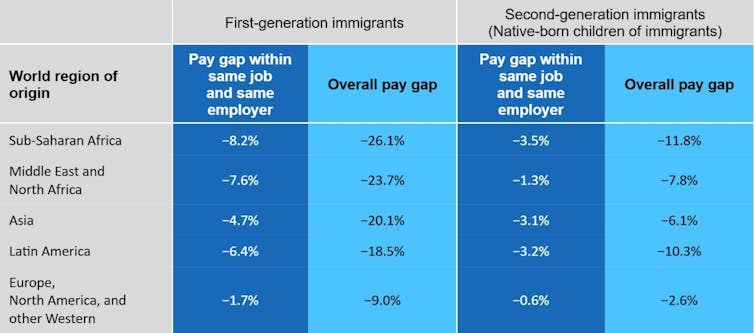Source: The Conversation – UK – By Dipa Kamdar, Senior Lecturer in Pharmacy Practice, Kingston University

As summer holidays begin, many travellers are packing more than just swimsuits and sunscreen – for millions, medicines are essential. But taking them abroad isn’t always simple. From legal pitfalls to temperature-sensitive drugs, here’s how to travel safely and legally with your medication.
Know the law
Medicines that are legal in the UK can be restricted or even banned in other countries. Having a valid prescription doesn’t guarantee you can take a medicine into another country.
For example, Nurofen Plus, which contains codeine (an opioid painkiller), is prohibited in countries like Egypt, Indonesia and the UAE.
Even common cold remedies containing decongestants like pseudoephedrine can land you in trouble in places like Japan and South Korea. This is because pseudoephedrine can be used to make methamphetamine (“speed”). Likewise, many stimulant ADHD drugs are also banned from these countries.
Get your news from actual experts, straight to your inbox. Sign up to our daily newsletter to receive all The Conversation UK’s latest coverage of news and research, from politics and business to the arts and sciences.
Some countries have restrictions on the amount of medication that you are allowed to bring into the country – usually a maximum of three months supply.
Travellers often overlook how strict customs regulations can be regarding medications. Even if prescribed for a valid medical reason, carrying a prohibited drug can lead to confiscation (leaving you without essential treatment), fines (especially in countries with tough drug laws) and detention or arrest in rare but serious cases.
If you’re travelling with certain controlled drugs – such as opioids, stimulants or psychotropic substances – you may need to apply for an export licence from the UK Home Office. This is typically required when carrying a supply of three months or more. Examples of controlled drugs include diazepam (for anxiety and muscle spasms), codeine and morphine (for pain), amphetamines (for ADHD) and temazepam (for insomnia).
Before you travel, check whether your medicine is affected by any of these restrictions. Use the country’s embassy website or the UK government’s travel advice to check the rules of your destination country.
This should provide guidance on whether you simply need a copy of your prescription, a doctor’s letter or a special import certificate (some countries require official documentation even for personal use).
The UK government advises carrying controlled drugs or any drugs that might be restricted in your hand luggage. You should take along a prescription or a signed letter from your doctor detailing your medication, dosage and travel dates.
Ensure you take sufficient supplies for the duration of your trip and include extras for unexpected delays, damage or loss.

olesea vetrila/Shutterstock.com
Store your medication properly
It might be tempting to save space by transferring pills or liquids into smaller containers or pill organisers. While this can be convenient, it’s not always advisable. Customs officials may not recognise unlabelled containers, increasing the chance of delays or confiscation.
Some medications are sensitive to light, air or temperature, and must remain in their original packaging to stay effective. For example, HRT (hormone replacement therapy) sprays like Lenzetto must not be decanted.
These products rely on precise metered dosing and specialised packaging to deliver the correct amount of hormone. Transferring them to another container could result in incorrect dosing or loss of potency.
Similarly, GTN (glyceryl trinitrate) tablets, used to treat angina, should always be stored in their original glass bottle. The active ingredient can evaporate if exposed to air, reducing the tablets’ effectiveness.
You might be worried about the 100ml liquid in hand luggage restriction – with a doctor’s letter certifying the need for this medicine, you should be able to take larger amounts of liquid medicine through security.
Medicines should always be kept in their original packaging with labels intact. When in doubt, ask your pharmacist whether your medication can be safely repackaged for travel.
It’s also important to split your supply of medicines between bags (if more than one is used) in case one is lost. Tablets and capsules can sometimes be placed in a pill organiser for daily use, but always carry the original box or prescription label as backup.
Some medicines require refrigeration – like Wegovy and Ozempic (semaglutide) injections for weight loss or insulin.
Usually, unopened Wegovy pens and insulin preparations should be stored between 2°C and 8°C in a fridge. Once out of the fridge, they can be kept at room temperature (up to 25°C) for up to 28 days, but must be protected from heat and sunlight. High temperatures, such as in direct sunlight or a hot car, can damage insulin.
When travelling, use an insulated travel case or cool pack, but avoid placing pens or other medicines directly next to ice packs to prevent freezing.
Airlines generally do not provide refrigeration or freezer storage for passenger items, including medicines, due to space and liability concerns, but it’s worth contacting them to see if they can help with arrangements for storage. Inspect insulin for crystals after flying – if any are present, it should be discarded.
You can bring needles and injectable medicines like EpiPens (for allergies), insulin or Wegovy in your hand luggage. But it’s important to carry a doctor’s note stating your medical condition and the necessity of the medication, and a copy of your prescription.
You should also declare them at airport security. Security officers may inspect these items separately, so allow for extra time going through security.
Contact your airline for any specific rules on needles and injectable medicines. Always carry such medicines and medical devices in your hand luggage – checked bags can be lost or exposed to extreme temperatures.
Don’t skip doses
Tempting as it may be to leave your medication behind for a short trip, doing so can be risky. Stopping treatment – even temporarily – can lead to relapse or worsening of symptoms (especially for chronic conditions like diabetes, hypertension or depression).
For medicines like antidepressants or opioids, people may start feeling withdrawal effects. You’re also at risk of reduced effectiveness if you miss doses of medicines that require consistent levels in your bloodstream.
If you’re considering a break from your medication, consult your doctor first. They can advise whether a short pause is safe or help you plan a travel-friendly regimen.
Take the right documents
While showing your NHS app to border officials may help demonstrate that a medicine is prescribed to you, it’s not always sufficient – especially when travelling with restricted or controlled drugs and injectable medicines.
Most countries require a copy of your prescription, and a doctor’s letter confirming the medication is for personal use. Your doctor is not legally obliged to issue this letter, but most will do so upon request.
It’s best to ask at least one to two weeks in advance, as some practices may charge a fee or require time to prepare the documentation.
Travelling with medication doesn’t have to be stressful, but it does require planning. With the right preparation, you can enjoy your holiday without compromising your health or running afoul of foreign laws.
![]()
Dipa Kamdar does not work for, consult, own shares in or receive funding from any company or organisation that would benefit from this article, and has disclosed no relevant affiliations beyond their academic appointment.
– ref. Going on holiday? What you need to know about taking your meds with you – https://theconversation.com/going-on-holiday-what-you-need-to-know-about-taking-your-meds-with-you-261018
























